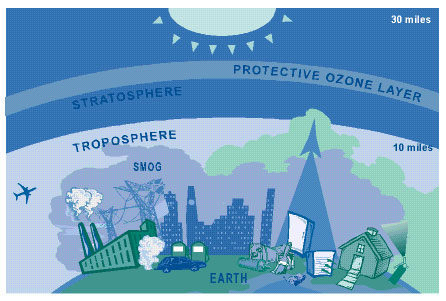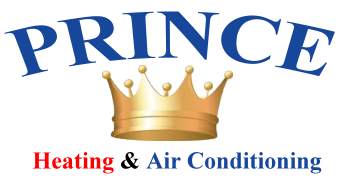Ozone Information
 An Introduction to Indoor Air Quality
An Introduction to Indoor Air Quality
Carbon Monoxide (CO)
Carbon monoxide is an odorless, colorless and toxic gas. Because it is impossible to see, taste or smell the toxic fumes, CO can kill you before you are aware it is in your home. At lower levels of exposure, CO causes mild effects that are often mistaken for the flu. These symptoms include headaches, dizziness, disorientation, nausea and fatigue. The effects of CO exposure can vary greatly from person to person depending on age, overall health and the concentration and length of exposure.
Sources of Carbon Monoxide
Unvented kerosene and gas space heaters; leaking chimneys and furnaces; back-drafting from furnaces, gas water heaters, wood stoves, and fireplaces; gas stoves; generators and other gasoline powered equipment; automobile exhaust from attached garages; and tobacco smoke. Incomplete oxidation during combustion in gas ranges and unvented gas or kerosene heaters may cause high concentrations of CO in indoor air. Worn or poorly adjusted and maintained combustion devices (e.g., boilers, furnaces) can be significant sources, or if the flue is improperly sized, blocked, disconnected, or is leaking. Auto, truck, or bus exhaust from attached garages, nearby roads, or parking areas can also be a source.
Basic Information on Pollutants and Sources of Indoor Air Pollution
- Asbestos
- Biological Pollutants
- Carbon Monoxide (CO)
- Formaldehyde/Pressed Wood Products
- Lead (Pb)
- Nitrogen Dioxide (NO2)
- Pesticides
- Radon (Rn)
- Respirable Particles
- Secondhand Smoke/ Environmental Tobacco Smoke
- Stoves, Heaters, Fireplaces, and Chimneys
- Volatile Organic Compounds (VOCs)
Health Effects Associated with Carbon Monoxide
At low concentrations, fatigue in healthy people and chest pain in people with heart disease. At higher concentrations, impaired vision and coordination; headaches; dizziness; confusion; nausea. Can cause flu-like symptoms that clear up after leaving home. Fatal at very high concentrations. Acute effects are due to the formation of carboxyhemoglobin in the blood, which inhibits oxygen intake. At moderate concentrations, angina, impaired vision, and reduced brain function may result. At higher concentrations, CO exposure can be fatal.
 Levels in Homes
Levels in Homes
Average levels in homes without gas stoves vary from 0.5 to 5 parts per million (ppm). Levels near properly adjusted gas stoves are often 5 to 15 ppm and those near poorly adjusted stoves may be 30 ppm or higher.
ALERT: Put generators outside.
Never use a generator inside homes, garages, crawlspaces, sheds, or similar areas. Deadly levels of carbon monoxide can quickly build up in these areas and can linger for hours, even after the generator has shut off.
Steps to Reduce Exposure to Carbon Monoxide
It is most important to be sure combustion equipment is maintained and properly adjusted. Vehicular use should be carefully managed adjacent to buildings and in vocational programs. Additional ventilation can be used as a temporary measure when high levels of CO are expected for short periods of time.
- Keep gas appliances properly adjusted.
- Consider purchasing a vented space heater when replacing an unvented one.
- Use proper fuel in kerosene space heaters.
- Install and use an exhaust fan vented to outdoors over gas stoves.
- Open flues when fireplaces are in use.
- Choose properly sized wood stoves that are certified to meet EPA emission standards. Make certain that doors on all wood stoves fit tightly.
- Have a trained professional inspect, clean, and tune-up central heating system (furnaces, flues, and chimneys) annually. Repair any leaks promptly.
- Do not idle the car inside the garage.
Measurement Methods
Some relatively high-cost infrared radiation adsorption and electrochemical instruments do exist. Moderately priced real-time measuring devices are also available. A passive monitor is currently under development.
Exposure Limits
Occupational Safety and Health Guideline for Carbon Monoxide, see www.osha.gov/SLTC/healthguidelines/carbonmonoxide/recognition.html
OSHA Note: This guideline summarizes pertinent information about carbon monoxide for workers and employers as well as for physicians, industrial hygienists, and other occupational safety and health professionals who may need such information to conduct effective occupational safety and health programs. Recommendations may be superseded by new developments in these fields; readers are therefore advised to regard these recommendations as general guidelines and to determine whether new information is available.
[OSHA PEL] The current Occupational Safety and Health Administration (OSHA) permissible exposure limit (PEL) for carbon monoxide is 50 parts per million (ppm) parts of air (55 milligrams per cubic meter (mg/m(3))) as an 8-hour time-weighted average (TWA) concentration [29 CFR Table Z-1].[NIOSH REL] The National Institute for Occupational Safety and Health (NIOSH) has established a recommended exposure limit (REL) for carbon monoxide of 35 ppm (40 mg/m(3)) as an 8-hour TWA and 200 ppm (229 mg/m(3)) as a ceiling [NIOSH 1992]. The NIOSH limit is based on the risk of cardiovascular effects.[ACGIH TLV] The American Conference of Governmental Industrial Hygienists (ACGIH) has assigned carbon monoxide a threshold limit value (TLV) of 25 ppm (29 mg/m(3)) as a TWA for a normal 8-hour workday and a 40-hour workweek [ACGIH 1994, p. 15]. The ACGIH limit is based on the risk of elevated carboxyhemoglobin levels [ACGIH 1991, p. 229].Additional ResourcesTo report a dangerous product or a product-related injury, call the Consumer Product Safety Commission’s (CPSC) hotline at (800) 638-2772 or CPSC teletypewriter at (800) 638-8270. Consumer can obtain recall information at CPSC’s website – www.cpsc.gov Consumers can report product hazards to info@cpsc.gov
